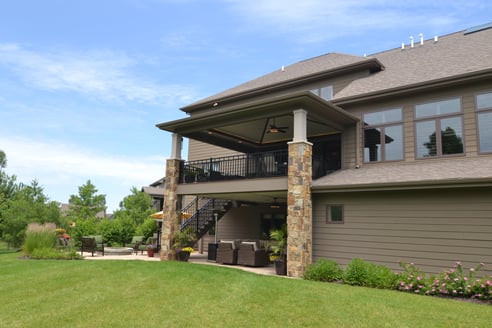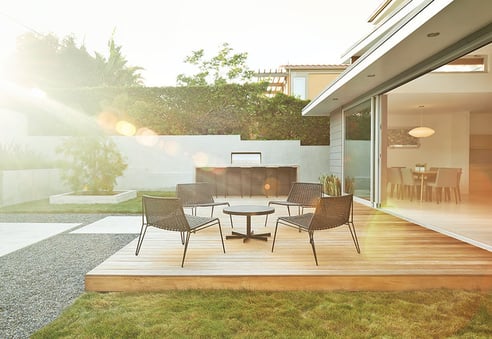In the past, if you wanted a new deck, you had one option for material: wood. It’s still used for the overwhelming majority of decks, but some new products are emerging on the scene that are changing things up a bit. Recently, we’ve installed stone decking on Des Moines area homes and we love this option for its aesthetic and durability. Here’s a quick breakdown of some decking options:
Pressure-treated lumber. This is the most commonly used deck material. It’s the most cost effective option, and is chemically treated to resist rot, fungus, and wood-destroying insects. But it tends to split and crack, and requires some maintenance in the form of annual power washing and application of stain or wood protectant every couple years. Plus, people are becoming rightfully leerier of using chemically treated materials.
Redwood and cedar. Decks made with these materials are beautiful. They’re not chemically treated, but are naturally resistant to rot, decay, and wood-boring bugs. However, these woods are also significantly more expensive than pressure-treated lumber. Left untreated, these decks weather to grayish/silver, which we love. But, some homeowners prefer theirs painted or stained. If you go this route, just be aware that this will mean a lot more maintenance, as it will have to be redone every few years. Be sure to use a high quality product in order to ensure the best results.
Tropical hardwood. These materials are very hard, durable, and resistant to rot and insects. They are more expensive than redwood and cedar, but require about the same maintenance. Ipe is a popular (but expensive) choice in this category and our personal favorite.
Side note on ipe. Here’s a timely article from Dwell on other places it can be used.
Composite and man-made materials. These decking options are made from things like PVC, vinyl, wood fibers, and recycled plastic. Some types are extremely resistant to weather and stains (although some are not). Most types also don’t splinter, warp, rot, or split, and require little no maintenance. There are many different options in this category, each with their own unique advantages/disadvantages and associated costs.
Stone. These tiles are great for a new deck if you want stone to perhaps coordinate with a lower patio. They may be an option if your deck needs improvement or significant maintenance, but you don’t want to do a full replacement, as some can be used with traditional deck frames (other cannot, so make sure you’re doing your homework). Most tiles are made of eco-friendly, rot-resistant materials, such as slate, granite, quartzite, and concrete.
These products are very new to the market, so it’s important to work with someone who understands the different options to make sure you’re getting the right product for your needs. For example, some products we’ve used at Kaufman Construction, are installed in a technique similar to that used for wood or composite decking, but some other options require considerably different framing practices, which can significantly drive up the cost.
Look for additional posts coming soon where we’ll delve into the pros and cons of these popular decking options. And keep in mind – if you want a new deck to enjoy next spring, it’s important to start planning now!
If your deck or patio requires maintenance or repairs, rather than a full renovation, reach out to our handyman service, we specialize in such tasks regularly throughout the Des Moines Metro and surrounding suburbs.
More inspiration: Our Houzz decks ideabook

















